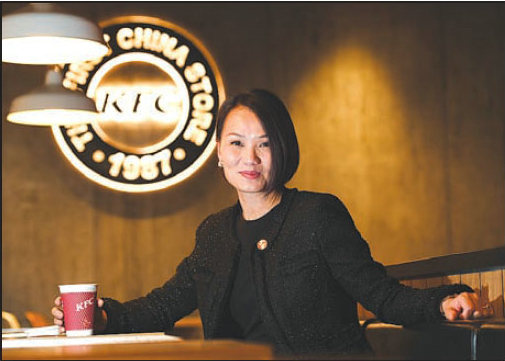 |
|
Joey Wat, president and chief operating officer of Yum China, the parent company of KFC. [Photo provided to China Daily] |
For many of those who grew up in 1990s China, having a meal at KFC was considered the highlight of the month. Many parents used the fast food chain as an incentive to get their kids to behave well and score good grades in school.
The instant and phenomenal success of KFC convinced its biggest rival, McDonald's, to embrace the market three years later. The latter first opened in Shenzhen where KFC had yet to establish a presence. Chinese copycat restaurants soon mushroomed across the country, creating a vibrant fast food landscape that thrived for as long as a decade.
Ronghua Chicken, founded by Shanghai's State-owned food and restaurant group Xinya in 1991, is one of the first copycats. The group claimed its chickens were infused with Chinese herbs before being deep fried, and paired the meat with Chinese fried rice and appetizers like spicy and sour cabbages.
The company quickly gained nationwide popularity, primarily because it was slightly cheaper than KFC and because locals were eager to support a local brand. Ronghua Chicken's daily turnover peaked at 119,000 yuan during the first two years, but it had by 2000 disappeared from the market. Industry insiders point out that their demise was due to a lack of experience in managing a chain business.
By 2007, fast food accounted for more than half of the country's restaurant businesses. While KFC and McDonald's are still the biggest players in the Chinese market today, their market shares have been declining due to increasing market size and competition as well as the growing awareness of healthy eating. Other factors include the bird flu epidemic and recurring allegations of food safety issues.
According to Euromonitor International, the market share of KFC in the Chinese restaurant chain industry in 2016 was 11.6 percent, down from 16 percent in 2012.
In a 2015 consumer report by McKinsey which polled over 10,000 residents in 44 Chinese cities, only 51 percent of the respondents said they had consumed Western fast food over the past year, down from 67 percent in 2012. But these findings have hardly dampened KFC and McDonald's resolve to broaden their footprint, with both companies having embarked on an aggressive expansion across China.
McDonald's recently announced that it plans to double its new openings from 250 per year to 500 over the next five years. KFC, which already has twice as many outlets as its rival, said there are no plans to slow down the pace of its own expansion and will seek to penetrate the more rural regions.
|
|
|
|
|
|
|
|
